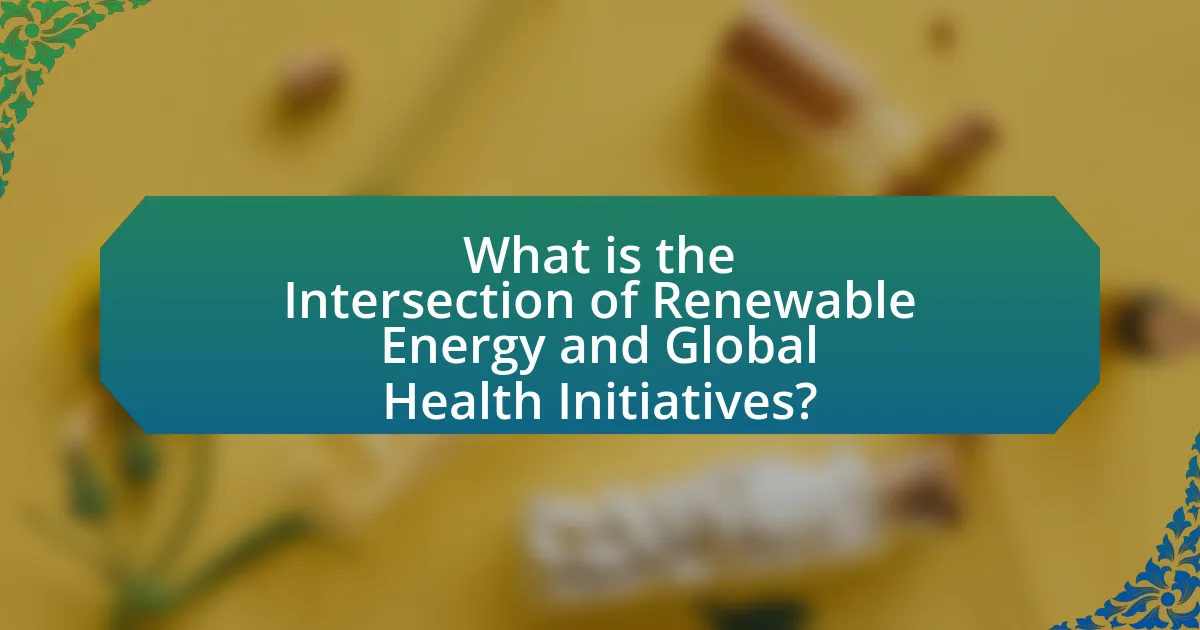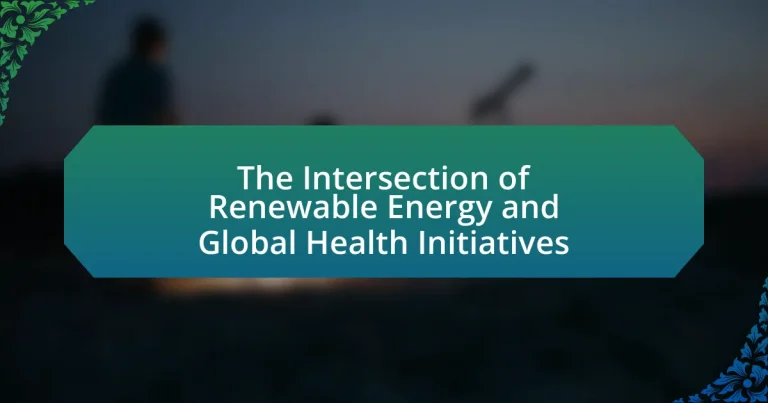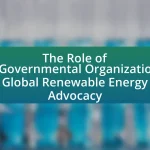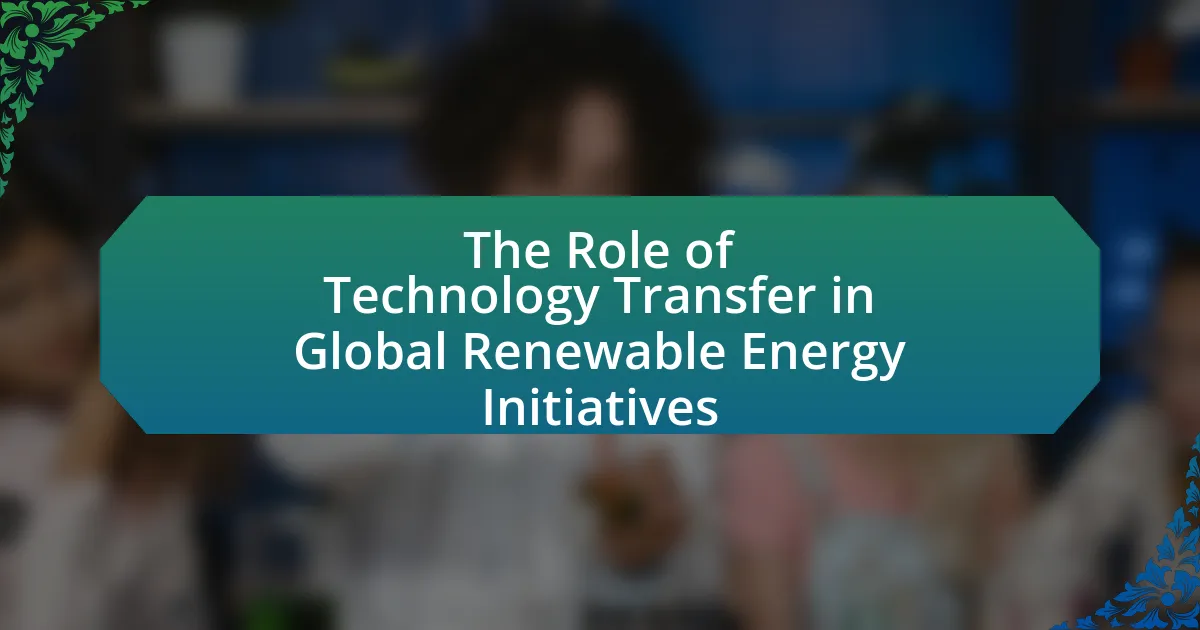The article examines the intersection of renewable energy and global health initiatives, highlighting how sustainable energy sources can enhance health outcomes and mitigate environmental health risks. It discusses the significant health benefits of transitioning to renewable energy, such as reduced air pollution and improved healthcare access, particularly in underserved regions. The article also addresses the challenges faced in integrating renewable energy into health systems, including financial constraints and inadequate infrastructure, while emphasizing the importance of policy frameworks and international cooperation in promoting these initiatives. Additionally, it explores emerging technologies and best practices that can drive the successful integration of renewable energy into healthcare, ultimately contributing to better public health outcomes.

What is the Intersection of Renewable Energy and Global Health Initiatives?
The intersection of renewable energy and global health initiatives lies in the ability of sustainable energy sources to improve health outcomes and reduce environmental health risks. Renewable energy, such as solar and wind power, decreases reliance on fossil fuels, which are linked to air pollution and respiratory diseases. For instance, the World Health Organization estimates that air pollution contributes to approximately 7 million premature deaths annually, highlighting the health benefits of cleaner energy sources. Additionally, renewable energy can enhance healthcare access in remote areas by providing reliable electricity for medical facilities, thus improving health service delivery. This synergy between renewable energy and health initiatives supports the achievement of Sustainable Development Goals, particularly Goal 3, which aims to ensure healthy lives and promote well-being for all.
How do renewable energy sources impact global health?
Renewable energy sources significantly improve global health by reducing air pollution and greenhouse gas emissions. The World Health Organization estimates that air pollution causes approximately 7 million premature deaths annually, primarily from fossil fuel combustion. Transitioning to renewable energy, such as solar and wind, decreases reliance on coal and oil, leading to cleaner air and lower rates of respiratory and cardiovascular diseases. Additionally, renewable energy can enhance access to electricity in underserved regions, improving healthcare services and enabling better health outcomes. For instance, a study published in the journal “Environmental Research Letters” found that increased use of renewables could prevent millions of deaths by 2030 due to improved air quality.
What are the direct health benefits of renewable energy adoption?
The direct health benefits of renewable energy adoption include reduced air pollution, which leads to lower rates of respiratory and cardiovascular diseases. Transitioning to renewable energy sources like wind and solar significantly decreases emissions of harmful pollutants such as sulfur dioxide and particulate matter. For instance, a study by the American Lung Association found that transitioning to renewable energy could prevent over 3,000 premature deaths annually in the United States due to improved air quality. Additionally, renewable energy systems often require less water than fossil fuel extraction and processing, reducing waterborne diseases associated with contaminated water sources.
How does renewable energy contribute to reducing air pollution?
Renewable energy significantly reduces air pollution by replacing fossil fuels with cleaner energy sources such as wind, solar, and hydroelectric power. The combustion of fossil fuels releases harmful pollutants, including sulfur dioxide, nitrogen oxides, and particulate matter, which contribute to respiratory diseases and environmental degradation. According to the International Renewable Energy Agency, transitioning to renewable energy could reduce global greenhouse gas emissions by up to 70% by 2050, leading to improved air quality and public health outcomes. This shift not only mitigates the immediate health risks associated with air pollution but also contributes to long-term environmental sustainability.
Why is the integration of renewable energy important for health initiatives?
The integration of renewable energy is crucial for health initiatives because it reduces air pollution and associated health risks. Transitioning to renewable energy sources, such as solar and wind, significantly lowers emissions of harmful pollutants like particulate matter and nitrogen oxides, which are linked to respiratory diseases and cardiovascular problems. According to the World Health Organization, air pollution is responsible for approximately 7 million premature deaths annually, highlighting the urgent need for cleaner energy solutions to protect public health. By investing in renewable energy, health initiatives can improve air quality, enhance community health outcomes, and reduce healthcare costs associated with pollution-related illnesses.
What role does renewable energy play in improving healthcare access?
Renewable energy significantly enhances healthcare access by providing reliable power to medical facilities, especially in remote and underserved areas. Access to electricity enables healthcare facilities to operate essential services, such as refrigeration for vaccines and medications, lighting for surgeries, and the use of medical equipment. For instance, a study by the World Health Organization indicates that approximately 1.2 billion people lack access to electricity, which directly impacts their ability to receive adequate healthcare. By integrating renewable energy sources like solar and wind, healthcare facilities can reduce dependency on unreliable grid systems, ensuring continuous operation and improved health outcomes.
How can renewable energy enhance the resilience of health systems?
Renewable energy enhances the resilience of health systems by providing reliable and sustainable power sources that reduce dependency on fossil fuels and mitigate the impact of energy shortages. For instance, solar and wind energy can power health facilities, ensuring continuous operation during emergencies or natural disasters, which is crucial for maintaining essential health services. According to a study by the World Health Organization, health facilities powered by renewable energy are less vulnerable to disruptions, leading to improved patient care and better health outcomes. Additionally, renewable energy systems can lower operational costs, allowing health systems to allocate more resources to patient care and preventive measures.

What are the challenges at the Intersection of Renewable Energy and Global Health Initiatives?
The challenges at the intersection of renewable energy and global health initiatives include inadequate infrastructure, financial constraints, and policy misalignment. In many regions, especially in developing countries, the lack of reliable energy infrastructure hampers the implementation of health programs that rely on electricity for medical equipment and refrigeration of vaccines. Financial constraints limit investments in renewable energy projects that could support health initiatives, as funding is often directed towards immediate health needs rather than long-term energy solutions. Additionally, policy misalignment between energy and health sectors can lead to fragmented efforts, where renewable energy projects do not adequately address health priorities, resulting in missed opportunities for improving health outcomes through sustainable energy solutions.
What barriers exist in implementing renewable energy in health sectors?
Barriers in implementing renewable energy in health sectors include high initial costs, lack of infrastructure, regulatory challenges, and limited technical expertise. High initial costs deter investment, as many health facilities operate on tight budgets. The absence of adequate infrastructure, particularly in rural areas, complicates the integration of renewable technologies. Regulatory challenges arise from outdated policies that do not support renewable energy adoption, while limited technical expertise hampers the effective implementation and maintenance of these systems. According to a report by the World Health Organization, these barriers significantly hinder the transition to sustainable energy solutions in healthcare settings.
How do financial constraints affect renewable energy projects in healthcare?
Financial constraints significantly hinder the development and implementation of renewable energy projects in healthcare by limiting available capital for investment. These financial limitations can result in reduced capacity to purchase advanced technologies, which are essential for integrating renewable energy systems, such as solar panels or wind turbines, into healthcare facilities. For instance, a study by the International Renewable Energy Agency (IRENA) indicates that healthcare facilities in low-income countries often face budgetary restrictions that prevent them from investing in sustainable energy solutions, leading to reliance on fossil fuels and increased operational costs. Additionally, financial constraints can delay project timelines and reduce the scale of renewable energy initiatives, ultimately impacting the quality and accessibility of healthcare services.
What are the technological challenges in integrating renewable energy with health initiatives?
The technological challenges in integrating renewable energy with health initiatives include issues related to energy storage, grid reliability, and the compatibility of renewable technologies with existing health infrastructure. Energy storage systems, such as batteries, are essential for managing the intermittent nature of renewable sources like solar and wind, yet current technologies often lack the capacity or efficiency needed for large-scale health applications. Grid reliability is another challenge, as many health facilities require a consistent power supply, and integrating renewable energy can lead to fluctuations that compromise service delivery. Additionally, the compatibility of renewable technologies with existing health infrastructure can pose difficulties, as many health facilities may not be designed to accommodate new energy systems, requiring significant retrofitting or upgrades. These challenges highlight the need for innovative solutions and investments in technology to effectively merge renewable energy with health initiatives.
How can policy frameworks support the intersection of these fields?
Policy frameworks can support the intersection of renewable energy and global health initiatives by establishing regulations and incentives that promote sustainable energy solutions while addressing health outcomes. For instance, policies that encourage the adoption of clean energy technologies can reduce air pollution, which is linked to respiratory diseases, thereby improving public health. Evidence from the World Health Organization indicates that transitioning to renewable energy sources could prevent millions of premature deaths annually by reducing exposure to harmful pollutants. Additionally, integrated policy approaches that align energy access with health services can enhance healthcare delivery in underserved areas, ensuring that communities benefit from both improved energy infrastructure and better health outcomes.
What policies are effective in promoting renewable energy for health benefits?
Policies that effectively promote renewable energy for health benefits include financial incentives, regulatory frameworks, and public awareness campaigns. Financial incentives, such as tax credits and subsidies for solar and wind energy installations, encourage investment in clean energy technologies, which reduce air pollution and associated health risks. Regulatory frameworks, like emissions standards and renewable portfolio standards, mandate the use of cleaner energy sources, leading to improved air quality and public health outcomes. Public awareness campaigns educate communities about the health benefits of renewable energy, fostering support for sustainable practices. For instance, a study by the International Renewable Energy Agency found that transitioning to renewable energy could prevent millions of premature deaths annually by reducing air pollution.
How can international cooperation enhance renewable energy and health initiatives?
International cooperation can enhance renewable energy and health initiatives by facilitating knowledge sharing, resource allocation, and joint research efforts. Collaborative projects, such as the International Renewable Energy Agency’s initiatives, demonstrate how countries can pool expertise and funding to develop sustainable energy solutions that also improve public health outcomes. For instance, transitioning to renewable energy sources reduces air pollution, which is linked to respiratory diseases; studies show that countries implementing clean energy policies have seen significant declines in health-related issues associated with fossil fuel use. This synergy between renewable energy and health initiatives underscores the importance of global partnerships in addressing both environmental and health challenges effectively.

What are the future prospects for Renewable Energy and Global Health Initiatives?
The future prospects for renewable energy and global health initiatives are highly promising, as the transition to sustainable energy sources is increasingly recognized as essential for improving public health outcomes. Renewable energy technologies, such as solar and wind, can significantly reduce air pollution, which is linked to respiratory and cardiovascular diseases. According to the World Health Organization, air pollution causes approximately 7 million premature deaths annually, highlighting the urgent need for cleaner energy solutions. Furthermore, investments in renewable energy can enhance energy access in underserved regions, leading to improved health services and better health outcomes. The International Renewable Energy Agency projects that the renewable energy sector could create millions of jobs globally, contributing to economic stability and health improvements. Overall, the integration of renewable energy into global health initiatives presents a synergistic opportunity to address both environmental and health challenges effectively.
How can innovation drive the intersection of renewable energy and health?
Innovation can drive the intersection of renewable energy and health by developing technologies that enhance energy efficiency and reduce pollution, thereby improving public health outcomes. For instance, advancements in solar energy and wind power can decrease reliance on fossil fuels, which are linked to respiratory diseases and other health issues. A study by the World Health Organization indicates that air pollution from fossil fuel combustion contributes to approximately 7 million premature deaths annually. By investing in innovative renewable energy solutions, communities can mitigate these health risks while promoting sustainable energy practices.
What emerging technologies are shaping the future of renewable energy in healthcare?
Emerging technologies shaping the future of renewable energy in healthcare include solar energy systems, energy storage solutions, and smart grid technology. Solar energy systems are increasingly being integrated into healthcare facilities to reduce reliance on fossil fuels, with studies showing that hospitals can save up to 50% on energy costs by utilizing solar panels. Energy storage solutions, such as advanced battery systems, enable healthcare facilities to store excess energy generated from renewable sources, ensuring a reliable power supply during peak demand or outages. Smart grid technology enhances energy efficiency by allowing real-time monitoring and management of energy consumption, which is crucial for maintaining critical healthcare operations. These technologies collectively contribute to a more sustainable and resilient healthcare infrastructure.
How can data analytics improve the integration of renewable energy in health initiatives?
Data analytics can enhance the integration of renewable energy in health initiatives by optimizing resource allocation and improving decision-making processes. By analyzing data on energy consumption patterns, health facility needs, and renewable energy availability, stakeholders can identify the most efficient ways to deploy renewable energy solutions. For instance, a study by the International Renewable Energy Agency (IRENA) found that data-driven approaches can lead to a 30% increase in the efficiency of energy use in healthcare settings. This optimization not only reduces costs but also ensures that health initiatives are more sustainable and resilient, ultimately improving health outcomes in communities reliant on renewable energy sources.
What best practices can be adopted for successful integration?
Successful integration of renewable energy and global health initiatives can be achieved by adopting a multi-stakeholder approach that includes collaboration among governments, NGOs, and private sectors. This approach ensures that diverse perspectives and resources are utilized, enhancing the effectiveness of programs. For instance, the World Health Organization emphasizes the importance of partnerships in addressing health challenges, which can be further supported by renewable energy solutions that improve healthcare access in remote areas. Additionally, implementing data-driven decision-making processes allows for the assessment of integration impacts, as evidenced by studies showing that countries investing in renewable energy have seen improvements in health outcomes, such as reduced respiratory diseases linked to air pollution.
How can communities effectively implement renewable energy solutions for health improvements?
Communities can effectively implement renewable energy solutions for health improvements by integrating solar, wind, and biomass energy systems to power healthcare facilities and reduce reliance on fossil fuels. This transition leads to decreased air pollution, which is linked to respiratory diseases; for instance, the World Health Organization states that air pollution causes approximately 7 million premature deaths annually. Additionally, renewable energy can enhance the reliability of electricity in healthcare settings, ensuring that essential services like refrigeration for vaccines and medical equipment function continuously. Studies show that solar energy installations in rural health clinics have improved patient outcomes by providing consistent power for medical devices and lighting, thereby increasing healthcare access and quality.
What lessons can be learned from successful case studies in this intersection?
Successful case studies in the intersection of renewable energy and global health initiatives demonstrate that integrating clean energy solutions can significantly improve health outcomes and reduce healthcare costs. For instance, the implementation of solar-powered health clinics in rural areas has led to increased access to medical services, as evidenced by a study in Kenya where solar energy improved the functionality of health facilities, resulting in a 30% increase in patient visits. Additionally, these case studies highlight the importance of community engagement and local partnerships, which enhance project sustainability and effectiveness. In Bangladesh, the Solar Home Systems program not only provided electricity but also improved maternal and child health by enabling better access to healthcare information and services. These examples illustrate that renewable energy initiatives can directly contribute to better health outcomes while fostering economic development and resilience in communities.




